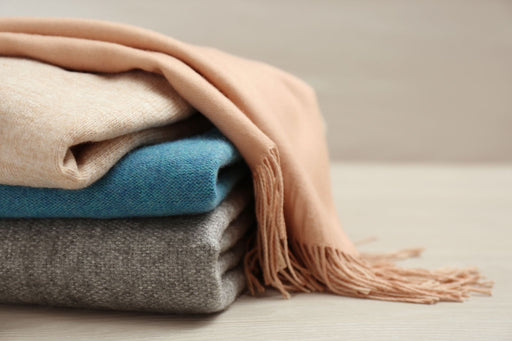The Differences Between 100% Cashmere and Cashmere-Blend Fabrics

When you look at your luxuriously soft cashmere garment do you ever think about where it came from? Did you know that it takes about four years for one Mongolian cashmere goat to shed enough wool to make a single cashmere sweater? Imagine how hard it would be to come across a 100% cashmere sweater or scarf that does not come with a high price tag. Plus, it takes a long time to sort through those wool fibers to find only the best cashmere fibers to be spun into a garment. With the rising popularity of cashmere, it makes sense that fashion designers and manufacturers would turn to cashmere blends to meet the demand.
You’re probably wondering: Are cashmere-blended fabrics worth it though? Should you purchase that cotton cashmere sweater or hold out for a sale on the 100% cashmere one? Are there actually advantages to cashmere blend fabrics?
We decided to take a deeper look at the differences between pure cashmere and blends to help you make an informed, fashion and environment-conscious decision.
What is 100% Cashmere?
Dig deep in your wallet! Cashmere isn’t referred to as a luxury fabric for nothing, and as such it commands a luxury price. This material is an extremely lightweight yet insulating fabric. Who doesn’t love the feel of soft cashmere sweaters, fluffy socks, hats, and scarves?
Cashmere Fiber Quality

A trip to your favorite clothing store will tell you a lot about different types of cashmere, and it might be hard to keep your wits about you when you find clothing that claims to contain near to 100% cashmere, only to feel it and find that the cashmere has been blended with another fiber. It’s common for cashmere to be blended with another wool or a mixture between two grades of cashmere.
If you’re looking for true 100% cashmere with the quality cashmere feel, you need to learn how to read the label. Presently, cashmere that comes from China is processed in volume and as such can be of a lower quality. High-end luxury wool mills are located throughout Europe and also Japan. Some of the best quality cashmere comes from Italy and Scotland. Yet, that same cashmere is worth thousands of dollars.
Know Your Cashmere Grades:
The differences in the quality of cashmere are articulated as “grades”. The cashmere grades are:
- Grade C: Lowest quality. The fibers are thick—around 30 microns, and short in length.
- Grade B: Thinner than Grade C. Average of 19 microns thick, and short in length.
- Grade A: Best quality with a small diameter of 14 microns; about 36 mm in length.
So, as you may have surmised, 100% Grade A cashmere is going to be more expensive than 100% Grade C cashmere. That’s despite both being 100% cashmere!
100% Cashmere vs. Cashmere Blends
So, we’ve established that even 100% cashmere garments have significant differences based on the grade of cashmere fibers used to make the fabric, but where do cashmere blends fit in?
Cashmere-blended fabrics can be made up of cashmere and a range of other fabrics, both organic and in lesser quantity, synthetic. Cashmere can be blended with other fabrics not only to make it easier to produce at volume, but also to enhance the properties of the fabric. So, blended doesn’t always mean “diluted” or lower quality...
Silk Cashmere
As the name suggests, this is a blend of silk and cashmere. Both silk and cashmere are luxurious fabrics that are soft and breathable. When silk is blended in with cashmere, it makes a garment easier to produce but does not negate too much of the insulating qualities of the cashmere wool. Furthermore, while silk alone might wrinkle, adding it to cashmere reduces the chance. Silk also helps cashmere from stretching out, keeping the shape of the garment for longer.
Overall, a silk-cashmere blend can be deemed an enhancement over pure cashmere, that is if the reduction in insulation isn’t too much of a compromise. The price can also be more reasonable than 100% cashmere. Silk is obviously still a delicate and luxurious fabric, so the feel of the garment is still sumptuously inviting - so much so, you may find yourself popping on your silk-cashmere scarf at any opportunity!

Cotton Cashmere
Far less expensive than a silk and cashmere blend, cotton cashmere is also a much less effective insulator. Since cotton is the opposite of cashmere in many ways, it tends to negate cashmere’s insulating properties. It is easy to manufacture, and the blend remains soft throughout the process and can tolerate dying. This allows for vibrant colored cotton-cashmere blended fabrics.
The biggest complaint with cotton cashmere blends, however, would be that the blend tends to stretch and wrinkle easily. Depending on the quality of the cashmere used, the price range will vary greatly. If you want a more durable cotton cashmere item, be sure to look for higher quality grade cashmere.
Wool Cashmere
Sometimes, you will find that cashmere has been blended with other popular wool types, like Merino wool. Shirts, sweaters, socks, sweatpants, cardigans, and more are produced with this blend. Usually, there is more wool in the garment than cashmere, sometimes making them slightly more itchy (depending on the quality of the materials).
That said, these garments tend to have excellent thermal abilities, are durable and hold up well under more testing conditions, are soft to the touch, and are also much cheaper than 100% cashmere.

Synthetics and Cashmere
Although you rarely see cashmere blended with synthetics, it does sometimes happen. In this case, it’s usually not the ideal mixture for clothing and may not be as insulating as desired. Socks, however, are a good choice for polyester or nylon blends, since it adds additional durability. So don’t be put off by synthetic blends, as these fibers do have their place in the cashmere-blend world!
Are Cashmere Blends a Bad Thing?
A cashmere blend doesn’t always mean a lesser quality garment or fabric. Think about it... How would you now compare a 100% grade C cashmere sweater vs a silk-cashmere blend using grade A cashmere?
OK, sometimes, a cashmere blend means you’re spending less; but in some cases there’s a really great reason to blend cashmere to get a superior fabric for a particular garment type or use.
When it comes to summarizing advice around blended cashmere fabrics; make sure you look for fabrics that have been blended with Grade A pure cashmere. If you’re looking for a luxurious cashmere sweater, consider a silk-cashmere blend as you might find it holds its shape better than a pure cashmere sweater. Even consider synthetic blends for garments such as socks as the synthetic fiber helps keep the shape of cashmere clothing and deliver some enhanced durability. Not forgetting wool-cashmere blends which can enhance the durability of the cashmere whilst not compromising a great deal on insulating properties.
The commonly held belief behind cashmere blends is that you’re getting pure cashmere for a lower price point - and this is demonstrated at the cash register. Some designers may charge US$1,000 for a 100% cashmere sweater but only $500 for a silk cashmere sweater. Similar brands might even drop that blend down to $200.

But don’t forget, blends might have a little more going for them than having a smaller price tag!
If you’re not all that concerned with getting the purest cashmere straight from Italy or Scotland, you have a range of available options when it comes to purchasing garments made from cashmere blends. Take Uniqlo, where they sell a range of cashmere blends. While the brand doesn’t disclose the quality of the cashmere, it’s believed to be a blend of Grade A and B cashmere mixed into other fabrics.
Remember to play to the strengths of your cashmere-blend fabrics. For instance, a silk cashmere shirt may not be quite as soft as pure cashmere, but you do get an elegant sheen and it’s more likely to keep its shape. A cotton cashmere blend makes the clothing more breathable and lightweight but doesn’t lose the softness of cashmere that so many people love. The best of both worlds!
Cashmere blends aren’t exclusively used for clothing of course, cashmere is commonly blended into household fabrics to create bedding, upholstery, pillow cases, home décor, and more. Cashmere can bring a softness and insulating quality to many fabrics around the home without being pure cashmere.
To blend, or not to blend...
100% grade A cashmere is indulgent, yet irresistible. Some of us cannot resist a gorgeous cashmere sweater or accessory. Now that you know the difference between 100% cashmere and cashmere blended fabrics, you shouldn’t have any trouble finding cashmere blend garments that fit with your needs, and maybe even your taste for expense! Remember, the right cashmere blends are great, but you should only choose the garments with Grade A or Grade B cashmere if you want to retain as much of that luxurious cashmere feel as possible.

About MothPrevention
MothPrevention® speak to customers every day about their clothes moth issues - clothes moths are a species that are ever increasing and that can cause significant damage to clothes, carpets and other home textiles.
To date, we’ve helped over 250,000 customers deal with their moth problems. We have developed professional grade solutions including proprietary pheromones and trap design, not available from anybody else in the USA.





